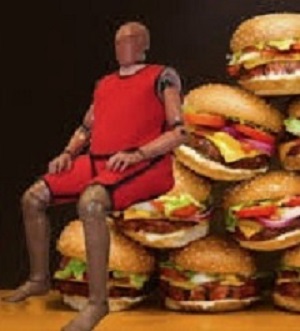 As the US population gets older and fatter, the crash-test dummies used to test the cars people drive are changing, too, with the most recent obese 144kg dummy a full 48kg heavier than its predecessor.
As the US population gets older and fatter, the crash-test dummies used to test the cars people drive are changing, too, with the most recent obese 144kg dummy a full 48kg heavier than its predecessor.
Recently, engineers at manufacturer Humanetics created dummies that reflect today's drivers: a 124-kg obese dummy that is 48kg heavier than the traditional model and a prototype for an elderly dummy based on an overweight 70-year-old woman.
The changes come years after Michigan Medicine trauma surgeon Dr Stewart Wang, told car safety engineers that "crash-test dummies look nothing like my patients." "You can't talk about injuries without talking about the person – it's individuals who are hurt," says Wang, who is a sought-after collaborator on car safety as the director of the University of Michigan International Centre for Automotive Medicine (ICAM). "The condition, size and shape of an individual is hugely important in how severe their injuries are in any given crash."
For example, in frontal crashes, obese drivers tend to "submarine," or slide under the lap belt; their lower bodies are also poorly restrained because their lap belts have much more slack.
As a result, they suffer more severe lower-extremity injuries at a much higher rate. Once they suffer such injuries, their obesity makes treatment more difficult and delays recovery.
"The typical patient today is overweight or obese – they're the rule rather than the exception," Wang says.
Wang has seen firsthand the devastating and often fatal injuries that occur during car crashes, and he helps translate complex medical information into concepts that automotive engineers can use.
His research has helped bring automotive safety research and engineering into the modern era, with insights based on detailed analysis of live patients from real-world crashes rather than laboratory testing of cadavers.
Teams at ICAM gain tremendous insight from hundreds of thousands of CT scans, which can quickly be used for 3-D printing of prototypes once they're shared with engineers. This has revolutionised the way dummies are made – and what they look like.
The new elderly dummy prototype has a BMI of 29, and its torso and chest have been substantially redesigned, sagging a bit more than the physique of the crash-test dummies safety testing usually relies on.
As the structure of the chest changes from the 20s to the 80s, the risk of chest injury goes up fifteenfold, Wang says.
"Few would have envisioned that people would drive into their 80s, but we have to look at that," says Chris O'Connor, president and CEO at Humanetics, which is based in Plymouth, Michigan. "As the population changes, we must have test equipment that resembles consumers today."
[link url="https://www.sciencedaily.com/releases/2017/01/170123093951.htm"]University of Michigan Health System material[/link]
